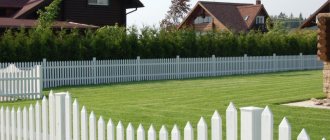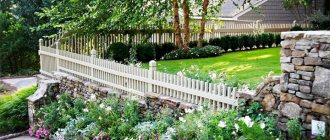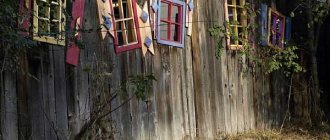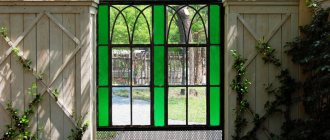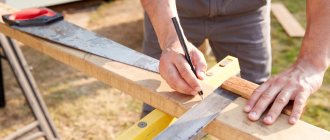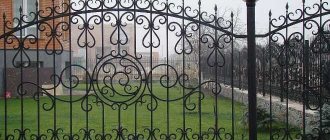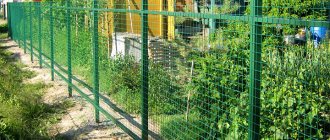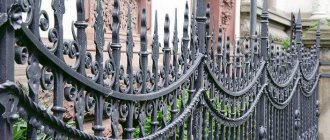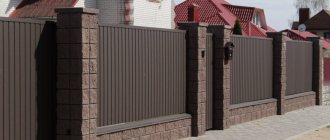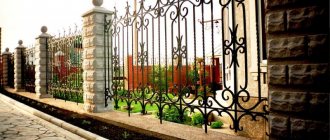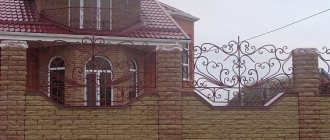Beton-House.com
Website about concrete: construction, characteristics, design. We combine the experience of professionals and private craftsmen in one place
Concrete fence
It’s a rare dacha plot without fences installed along its perimeter. The fence performs both protective and decorative functions, helping to give a finished look to a private area. There are many materials for making fences.
You can install sections of chain-link mesh at the boundaries of your property, which does not allow you to hide vacationers from prying eyes, or use a picket fence, which will not last as long as you would like. In terms of its operational and decorative qualities, a concrete fence for a summer residence is one of the most advantageous options today.
- Installation of a stacked fence
Advantages and disadvantages of concrete fences
Such fences are made from heavy concrete and steel reinforcement. This makes the fence resistant to temperature changes, stretching and compressive loads. Such a structure does not require a solid foundation, like brick fences. In addition, concrete slabs:
- protect the territory from prying eyes;
- create reliable protection against intruders;
- withstand significant loads, including hurricane winds, mechanical shocks;
- quickly installed;
- fire resistant;
- undemanding in care;
- absorb noise;
- If desired, the concrete surface can be painted.
According to the new SNiP for the planning and development of gardening associations, the fence between sections should be lattice or mesh and no higher than 1.5 m. Some models of concrete fences meet these requirements.
But there are also disadvantages. So, to install heavy slabs you need special lifting equipment or at least a team of strong assistants.
Depending on the design, there are several types of fences:
- Monolithic. These are massive slabs, the installation of which requires trucks.
- Typesetting walls. They are sections that consist of several plates connected to each other. The lower part of each element is solid, the upper part has a through pattern. Each panel weighs 50–70 kg.
Depending on the installation method, there are several types of concrete fences - on glass, free-standing, Euro fences.
Panel characteristics
Advantages of concrete construction
The wide range of applications of reinforced concrete fences is due to a number of advantages compared to other types of fencing:
- convenience and ease of installation;
- reliability and durability of operation;
- no need for slab maintenance;
- fencing effectiveness.
Smooth concrete slabs
Basic properties
Panel concrete fences are characterized by:
- Reliable protective function of the territory or site;
- Additional protection of the area from wind and dust;
- Soundproofing function;
- Solidity and stability of the structure;
- Variety of panel textures. Fencing panels can be given a perfect smooth surface or a variety of designs;
- Possibility of manufacturing decorative reinforced concrete panels;
- A variety of fencing colors. Pigmented concrete is used in production, which makes it possible to produce sections of any color;
- Possibility to choose the height of the structure. The height of industrial fencing ranges from 2.5 to 4.0 meters, and for private use the height can start from half a meter.
Photos of textured sections
Types of structures
Concrete fence panels are manufactured:
- whole;
- prefabricated (assembled from two or more slabs);
- one-sided;
- double-sided.
Industrial concrete fence
According to the scope of use, reinforced concrete fence panels are:
- Decorative - for use mainly in the private sector. The price of such a fence will be lower than a stone or brick one. In addition, the area is additionally protected from dust and noise. In addition, they also perform an aesthetic function. Modern casting technology makes it possible to implement a variety of design solutions;
- Industrial - for fencing the territory of enterprises, organizations and institutions. The products are designed for use under heavy load conditions.
Decorative fence
Self-standing fences
These are monolithic structures that do not require a foundation. At the bottom they have a profile in the form of an inverted letter T or G, which plays the role of a foundation.
The advantages of self-standing slabs include:
- minimal excavation work;
- the structure can be dismantled and reused;
- quick installation if lifting equipment is available.
Self-standing structures are especially in demand in areas with groundwater.
Usually, pouring a foundation there is expensive, since there is a need for reinforced reinforcement and deep planting of the foundation.
Such fences are only useful on level ground. And when you need to fence off an area located on a slope, use panels on glasses.
In addition, they cannot be installed on loose soil without compacting it, since the weight of one element reaches 2 tons.
Installation of a free-standing fence
Before starting work, study the location of power lines on the site in the area where the crane is supposed to be used.
Then you need to obtain a permit to carry out work from the company that owns the power transmission line, or from the responsible employee of the construction and installation organization, if he has such a right.
The installation itself is carried out in this order:
- Mark the territory.
- According to the markings, dig a trench with a width equal to the base of the slab plus 20 cm and a depth of 15 cm.
- Sand, crushed stone or rock screenings are poured into the recess in layers, compacted thoroughly.
- Plates are installed.
- Separate elements are fastened by welding on embedded parts.
A cushion under a slab of sand and crushed stone prevents the soil from becoming soggy during rains.
Concrete slabs on glasses
Such fences are built from two parts:
- plate;
- a glass part that acts as a foundation.
The slabs in these designs can be with or without an apron. Sections of the first type are installed if the glasses remain on the ground. The second ones are for foundations immersed in the ground.
Such fences are installed in two ways:
- the glasses are buried in the ground, and then slabs are inserted into them;
- First, the base for the glasses is concreted, and only then the sections are fixed.
Sometimes companies offer to purchase used concrete fences, which can be approximately half the price of new ones. If you want to save money, then the structure needs to be inspected. Pay attention to whether the mounting loops by which the slabs are lifted are intact and whether there is any damage to the concrete elements.
Washed concrete
Particularly worth noting is the technology for the production of “washed concrete”, when at one stage the top layer is removed, exposing the stone chips included in its composition. This approach allows you to achieve a decorative look without extra costs.
Stones give a fence or fence a natural and natural look that fits perfectly with green shrubs and other plantings.
Concrete eurofences
This is the name for stacked type fences, consisting of two components - concrete slabs and supports with grooves.
This is one of the most popular types of fences made from concrete, which are popular in individual households, gardens and summer cottages.
The advantage of such structures is that installation does not require special equipment.
Sergey
builder
The work can be completed by a team of 3-4 people. The fence does not need a foundation - you just need to concrete the support pillars.
— Sergey builder
Fence installation
Installation of the eurofence is carried out in the following order:
- The territory is marked in accordance with the dimensions of the structural elements.
- Dig a hole 70–80 cm in diameter, 20 cm wider in diameter than the side of the post.
- Insert the first post and fix it in the hole using broken bricks or crushed stone.
- Fill the hole with the solution.
- Install all supports.
- They wait for the concrete to set, but not less than a day.
- Insert the plates into the grooves.
In areas with difficult terrain, poles are installed in “steps”. Then it may be necessary to trim the panels or increase the length of the groove in the post. If you need to make a turn, then use two support pillars at once.
The method when supports are installed immediately has two disadvantages:
- you need to mark the area so that the slabs fit exactly into the side recesses on the supports;
- the sections will have to be lifted above the supports, and they are quite heavy.
The second method is considered more convenient. It looks like this:
- The first pillar is installed and concreted as described above.
- Plates are inserted on both sides.
- The second post is placed on the slab, and only after that is fixed in the ground.
- Continue installation according to the same scheme.
- Check the position of the slabs vertically and horizontally.
- Fill the holes with cement.
Mistakes made when installing a European fence
Often, after installation, the supporting part of the fence is destroyed.
This is due to the fact that the depth of the initial installation is not maintained, when some pillars are higher than others.
Another problem encountered due to improper installation technology is sections falling out. This happens if the posts are spaced too widely.
With a groove depth of 4 cm, the slab should fit into it at least 3 cm (or 75%). If this requirement is not met, the sections are damaged at the corners.
Sergey
builder
Usually, installation defects become noticeable after a year of fencing operation.
— Sergey builder
Construction of a fence
It prevents a vacuum from forming between the surface of fresh concrete and the wall of the form. Before the vibration starts, the holes are closed, and after it is completed they are opened. The simplicity of the technology and the availability of working equipment suggest the possibility of independent production of a Eurofence.
The answer to this is ambiguous and depends on the number of slabs and pillars you need. If we are talking about several dozen structural elements, then it is better to purchase them from the manufacturer. If fencing a site requires several hundred posts and sections, then it makes sense to buy equipment, forms for a European fence and do it all yourself.
The video shows an example of unacceptable savings on reinforcement when, instead of mesh, individual pieces of wire are placed in concrete.
Caring for a concrete fence
As already mentioned, maintaining concrete fences is easy. One of the most important activities is timely cleaning of the fence. For this you will need:
- soap or special detergent for concrete surfaces;
- pure water;
- garden hose;
- sponge.
Soap is dissolved in water (the concentration depends on the degree of contamination of the slabs). If detergents are used, dilute them according to the instructions. Soak a sponge in the solution and wipe the surface of the panels, then rinse with clean water. It is convenient to use a garden hose for this.
If the concrete has not been treated with antiseptic impregnations, it may become covered with moss. Vegetation is cleared from the fence using a brush. It is most convenient to use construction material with metal pile.
Reliability criteria for a contractor company
You need to know that the technology for manufacturing reinforced concrete slabs, unlike installation, is quite complex. When ordering a reinforced concrete fence, the client can count on the high quality of the future fence if:
- In the production of concrete blocks, only special high-class concrete is used, which is characterized by increased strength and resistance to climatic conditions. Thanks to high-quality raw materials and correct production techniques, an installed fence made of concrete sections will last a long time and will be able to withstand a significant level of external influence.
- Installation of the concrete fence occurs in compliance with the necessary technical requirements. A professional approach to installation contributes to the long-term stability of the fence.
- Upon completion of installation work, the customer receives a completely finished concrete fence that does not require additional processing.
Based on this, the company must have its own production plant, a staff of qualified engineers and foremen, and also be a legal entity. It must be remembered that the quality of the future fence directly depends on the company’s capabilities, and therefore, the more capacity it has and the more serious its staff, the higher the guarantee of obtaining high quality.
